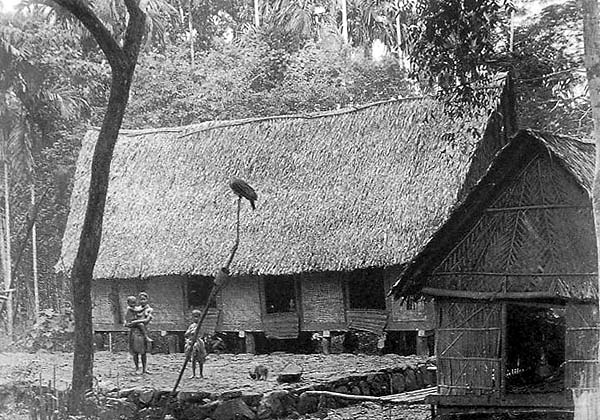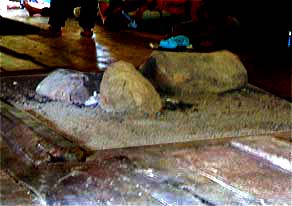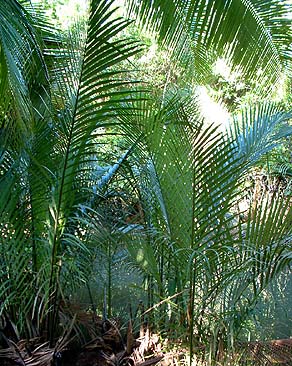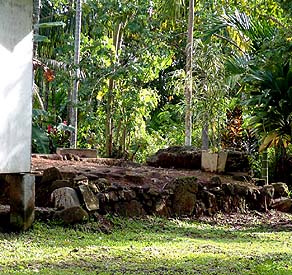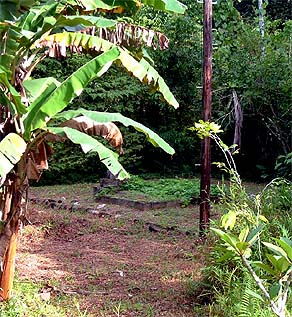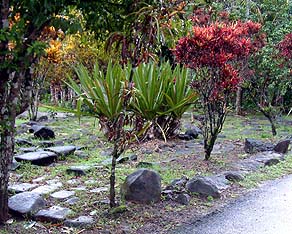 |
 |
 |
 |
||||
|
|
|
|
|
|
|
|
|
|
|
|||||||
“The Palauan house follows a very, very simple concept like the Chinese Feng Shui—geomancy, the art of positioning,” Johnson explains. “Basically it is the concept of symmetry, balance, and conformance with nature. In Palau we have a similar concept, a traditional way of architecture, even though we had simple houses. "In a home or in a family dwelling house, you don’t put
the door in the middle, at the center. That is what they call the divine
center or divine mid-section. I guess it is where the joint is and it
breaks easily. So that is for the gods. Instead, you put the door a
little off the mid-section. Then normally a cooking area, úum,
would be on the left side as you stand at your main door facing the
road. The left would be the úum side, and the right
should be the sleeping area for the elders and the young members of
the family when they are sick.”
|
||
|
|
||
|
“The Palauan house traditionally is just one rectangular structure,” Kathy explains, “and the size of the house depends on the number of doors. There’s a two-door house, there’s a four-door house and so forth, and the longer and the bigger, the more doors there are. "The one closest to the head of the house, it’s called cheldeng, it’s a sacred place where all the valuables and the spirits and so forth reside. And then there’s the middle of the house where the husband or the chief stays, and then there’s the other part at the end for cooking and for socializing. The fireplace wouldn’t be in the middle. It would be toward the end of the house.”
|
|
|
|
“In shape they were almost similar to the shape of the bai,” Walter says, “and made from the same local materials. We used to make the thatched roof out of a type of pandanus, we call it búuk. And then came the nipa palm. It’s not local, it came maybe from the Philippines or that part of Asia. The seeds float, just like coconuts. That is much more recent, and we call it tóechel. And then you get materials from the fronds, we call it melóuch—'to cut leaves.' And that’s when the roofing changed. “We use a lot of rope made from the coconut husk—the fibers make rope, and so we use a lot of that to tie it together. Just like they do with the Palauan bai. They didn’t use nails. And the hearth inside the house, they are elevated on posts too. And we used bamboo flooring."
|
|
|
|
“A big family would live in the house, in those days. And they didn’t have rooms, except what we call cheldeng. That is a special part of the house that only maybe the father and the elders could go. It is where they stored all the precious family things. And they’d put up a sort of curtain or partition— something like a screen, not actually a wall—to block it off. But otherwise it was an open floor. “What you see today, if you go into Palauan house, they are really different than the traditional Palauan houses back in the old days. Today it is like a modern architecture, maybe borrowed from Japanese, because Palauan traditional houses were different. It has changed. Now a younger person just married could afford a house, and they out move to their own house. It wasn’t like that in the olden days. Everything was like centralized."
|
||
|
|
||
|
| “There’s a stone platform that sits in front of the house,” Kathy points out, “and is several feet raised up from the ground. It’s built with stones, rectangular, stones. The house would be built behind, on stilts so it’s normally higher than the platform, and situated so that when you approach the house, you come from the other side of the platform toward the cooking area. "When you approach the house you go to the place where the head of the family regularly sits. You approach it and you come to the end of the house. You know which end it is because of the the way the house is situated in a village. It is a subject that everybody in a village knows. “The platform is a burial place. It is also an extended place for socializing. The head of the clan gets buried there, or the senior members of a clan, female members of a clan gets buried there, some of the children gets buried there. Not everybody. If it’s a clan house, that’s where they get buried. This gives credence to the settlement.”
|
||
|
|
||
|
“The chief’s house platforms were just like any house platform,” Walter adds, “except they were raised up a little and bigger than most of the villagers’. Bigger than just the regular house platform. And some have uprights on it, stone uprights. In some villages they have two layers—two-tiered platforms. “The platform itself has a name. That is how they identify the house. It’s a platform name, that is the center of that traditional family. If they wanted to call people of this area, they would just say ‘from this blai’: ‘they are people of Tkar,’ for example. They are like place names, but it is actually the name of the platform itself, the central house platform for that family from generation and generations.”
|
|
|
|
“During the Japanese times, burials were one of the things the Japanese were very strict about,” Kathy remarks, “and that’s why we began to have public cemeteries. Japanese outlawed burying your people in the stone platforms, they said for health reasons. So communities and the heads of our villages were required to designate pieces of public property where people would get buried, and then begin our public cemeteries. “We still bury some in the platforms today, and one of the reasons why you get buried there is to show your rank, your rank within the clan. Because only titled people, heads and important members of the clan gets buried in the platform. So nowadays in order to exert your ownership and your legal rights to the clan, or to show you’re a senior member of the clan, most are buried in the stone platform."
|
|
|
|
“In Airai and Koror the house normally faces the north or the south,” says Johnson. “I think that makes sense, because a Palauan house is an elongated A-frame. So if you face north and south, the sun rises and climbs over the apex of the building, which keeps it cool. If you had bigger house facing the east and west, as soon as the sun rises then the whole house would be illuminated with both the light and the heat. "But if it is facing north and south, in the morning—if you face the north—the sun would warm your sleeping area, and you walk over to the cool side of the cooking area. Or if you face the south in the morning it is cool in your sleeping area, but you go to the cooking area, where it is hot and you start working. It really makes sense. These concepts to me are a product of centuries of observation and adaptations. Some say it is superstitious, but it is just common sense, living with nature.”
|
||
|
|
||
| “It is the tradition here in Airai that they built a house facing north,” Walter says. “Especially when it is facing the road, the traditional pathways. But it is different in other villages, depending on the direction of the wind. You can tell from any village, if you go there. Just look at the houses and how they are positioned in the village, and you can see: the whole village would be aimed to the direction of the wind. Mostly they are facing east or north. Sometimes south, but not often.” “Building a house according to the way the sun rises or the wind blows, that’s a skill that craftsmen and master builders possess, Kathy emphasizes, "and when you build a house, you just don’t commission it from anybody to build it. You find one of these master builders, a person who knows how to build a house. "We believe that if your house is constructed properly, following tradition, then you will have less misfortune, less tragedy, more food, more money coming into the house. We believe in those kinds of things. “Nowadays when you build from concrete, it’s a little bit different but I understand some of those principles are still applied, even when you construct these modern houses."
|
|
|
|
|
Beyond the houses of the village, there are some structures that are much larger and grander, and serve greater community roles. These are the bai, and in Airai Village sits the last traditional such building in Palau, the Bairairrai.
|
||
|
|
||
|
|
|
|
|
|

|
| Airai Home | Map Library | Site Map | Pacific Worlds Home |
|
|
|
|

|
|
|
|||
| Copyright 2003 Pacific Worlds & Associates • Usage Policy • Webmaster |
|||
